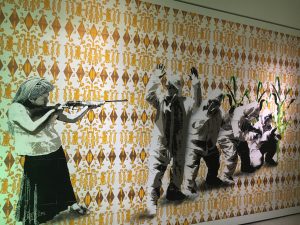As a student of the CAP stream Global Citizen, I was given the task to visit the Museum of Anthropology (MOA) at UBC, have a look at the “Arts of Resistance” exhibition and share my thoughts on it. The curator, Laura Osorio Sunnucks, tried to construct an imagine of the political issues in Latin America by using contemporary art. Wandering through the five sections of the exhibition, graffiti stencils from 2006 in Oaxaca caught my attention. Without being introduced to the context yet, a woman pointing a rifle at four people dressed in chemical protective body suits immediately created a very intense but not too unfamiliar image for me. The struggle between traditional and scientifically more developed methods seems to occur more frequently in today’s world conflicts. Not only that, but reading through the small information slide next to the graffiti, I realised that it also reflected on the oppression of indigenous societies and poverty problems in Mexico, especially in the city of Oaxaca.

“The Defence of Maize”
In the background, one can see the Aztec symbol for maize and a symbol representing Centeotl, the mexican maize goddess. Maize always has been essential to the Aztec life as a source of food and income. Additionally to the economic importance, it was also used when making sacrifices to god, thus having a deep cultural value for the Indigenous people (Bateman, 2006). I imagine that the genetically manipulated maize introduced by the government increases the quantity of the maize and lowers the prices which, in a by poverty characterised region like Oaxaca, comes at peoples liking. Nevertheless, it robs the indigenous people of their primary resource as well as, and maybe more importantly, a part of their culture.
As Sunnucks points out, the graffiti displayed, like one of many which started to cover the walls in Oaxaca, was made during a time where human-right movements were on the rise demanding better education in rural areas. Since the police used force to oppress the local and indigenous people, the artworks in form of graffiti exemplify solidarity and a form of silent rebellion. Nowadays, governments quickly happen to ignore the needs and tradition of minority populations. From my experience, indigenous societies are often only tolerated by the government since they create an economy of tourism. This appears to be the case in Oaxaca too. While the “exotic” culture of the Aztecs is exploited by the government to attract tourists, their values and traditions are being abandoned. I am confident in using the word “exploited” here since the profit made through indigenous tourism will not reach the local people.
When the graffiti would have been no more than an contentious imagery before, through questioning the meaning, researching the symbolism and looking for the purpose of its origin, it is now opening the door to get an insight into the perspective of the indigenous people, their opinion, values and traditions. One of our leading questions throughout the ASTU course is: How are memories stored in cultural artefacts? Looking at the graffiti, people are reminded of Centeotl, that his spirit, maybe his essence, is connected to the maize. However, the main point of the unknown artist, which I assume was a part of the Asociacion Popular de Pueblo de Oaxaca (APPO), was probably to reflect on the current political situation. That the people feel threatened and see the government as an illegitimate invader. That they, like the protest in 2006 indicate, are willing to protect their culture and traditions as well as their rights to education and equality. As we learned from Kate J. Waites in her biography “Sarah Polley’s Documemoir Stories We Tell: The Refracted”, works of art are used to show the truth from a selective perspective. The chosen piece of art above gives us insight in the local people’s conception of their current situation and ultimately tells us their personal truth.
The “Arts of Resistance” exhibition helped me to construct an image of the political issues in Latin America. The graffiti “The Defence of Maize”, in particular, enabled the creation of a connection between the values of the indigenous people and the political injustice they experience. I can clearly see how the memory of this frame of time is being stored. But it also lets me raise the question if the one-sided perspective displayed here makes it less of worth of a truth? Is it an individual memory or a collective memory? Is it an individual memory influenced by the collective memory? Who’s memory is it?
Citation
Bateman, Penny. “Why Did the Aztecs Worship Maize?” Mexicolore, 2006, www.mexicolore.co.uk/aztecs/ask-experts/why-did-the-aztecs-worship-maize.